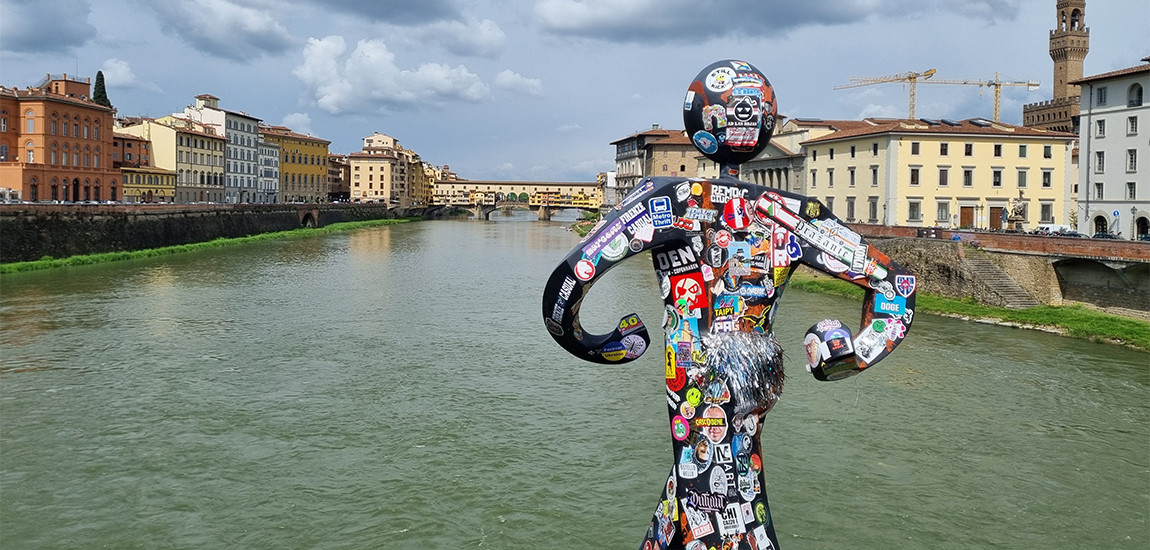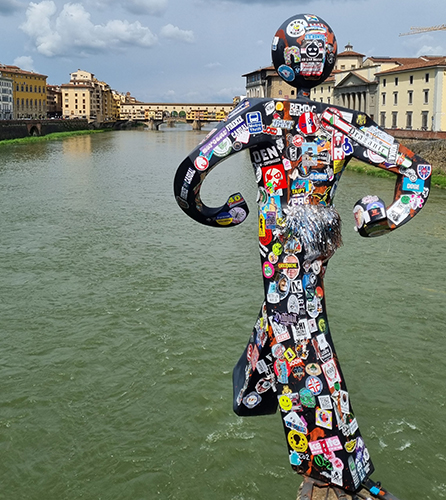
Clet's Common Man on Ponte alle Grazie
On Ponte
alle Grazie, a man leans out and bravely steps into the void.
The man is that of the installation by Clet, a French artist who has lived for
many ears in Florence, where he opened his studio in Oltrarno, becoming famous
for his interventions on road signs.
L’Uomo Comune (The Common Man) is a
work that had a really troubled life. Contested, vandalized, removed, fined and
finally reinstalled, it has now become a symbol of the city.
Appearing for the first time on the bridge overlooking Ponte Vecchio in January
2011, this sculpture immediately aroused curiosity, but also much dissent.
The work was soon removed only to return in 2013, causing even more trouble.
The sculpture was then damaged by vandals and removed, but the artist did not
give up and put it back in his place.
He was subsequently fined for having installed the work without authorization
in a place of scenic interest. The fine of 10 thousand euros was later canceled
on appeal.
The work finally returned on a permanent basis on the Ponte alle Grazie in
2021, enjoying great success.
What happened to Clet's Common Man, eventually became a metaphore for what actually
happens to the common men every day, often reduced to ask for authorization to
take any step forward.
The artist states that the work "is
a monument to the ordinary person who daily navigates these thousand
difficulties, a free figure who takes a step towards the unknown, and asking
for authorization for this would really diminish its meaning." ; and
reiterates in a post on his Instagram profile: “You cannot ask permission to take a free step, if not, what kind of
free step is it?”
He’s not wrong.
The work has been vandalized several times over the years, some of these
"interventions" have even been approved by the artist, aware of the
fact that street art is often fleeting, constantly evolving and that on the
streets the border between art and vandalism is subtle. The act of modifying an
art work or a wall or a road sign embodies people's need to express themselves,
often time with dramatic gestures. Sometimes these additions to the work were
funny, like the saucepan that was put on the man’s head as a hat or the scarf that
was placed around his neck.
Even the bucketful of red paint that was thrown on the statue seems to have
been appreciated by the artist, a lover of the color red. Clet finds in it a
reference to blood and violence, which is part of men, and therefore he reads a
message in it, it communicates something to him.
On the contrary, accrtding to the artist, what communicates nothing but is just
an imposition of one’s own ego, without correlation with the object, are the
numerous stickers that have been put on the statue, almost covering it head to
toe. For now he has decided to leave them, hoping that people will see for
themselves how little they can contribute to the message of the work itself,
but in all likelihood he will soon have them removed.
With his work Clet wants to convey a clear message to passers-by: he wants to
convey hope, showing a man who indeed is taking a step into the void, but does
so with confidence and pride. He knows he can do it.
We are all ordinary men, and one step into the unknown after the other, we move
forward.




